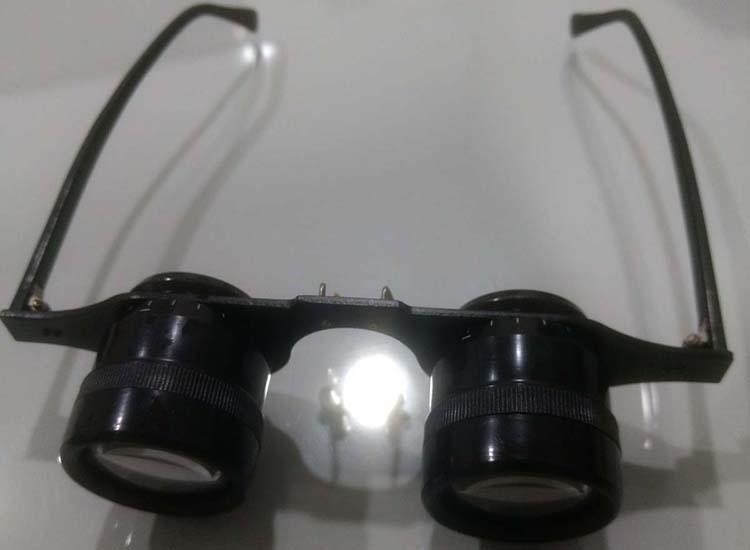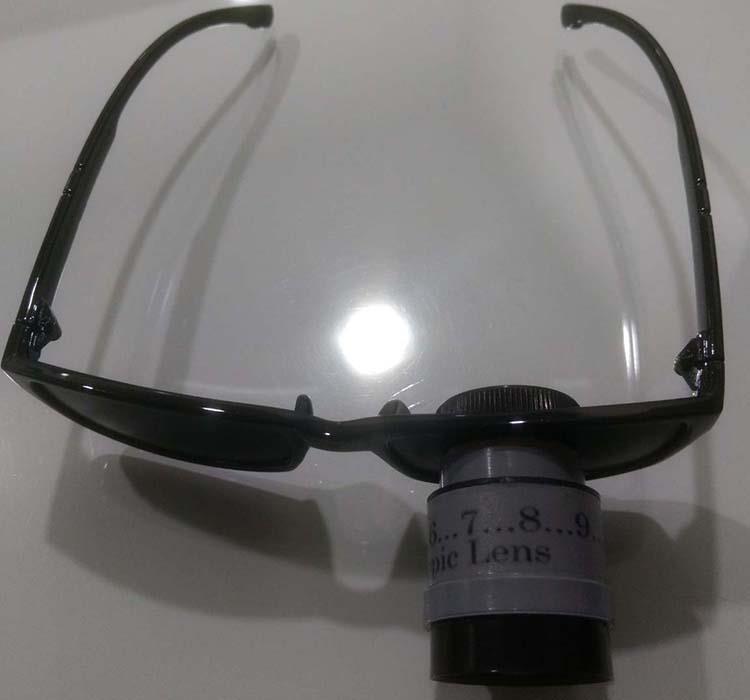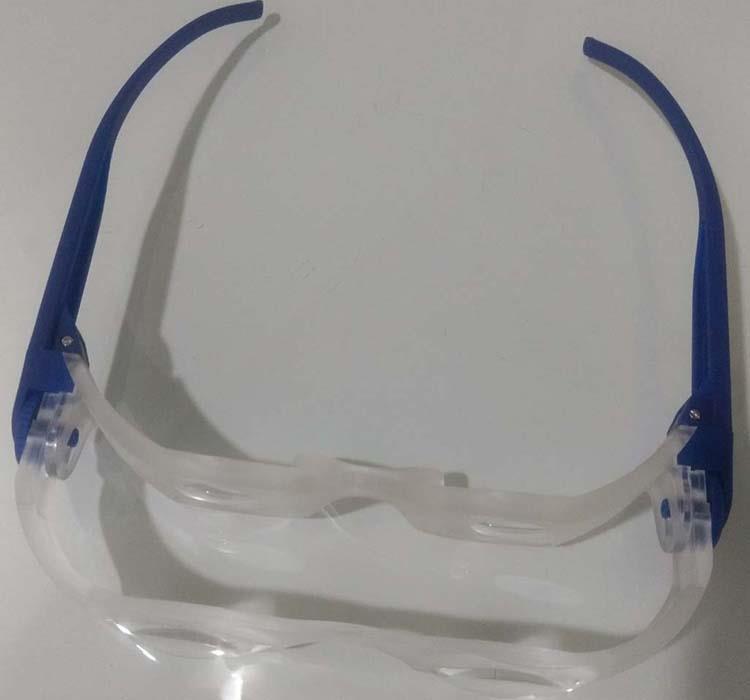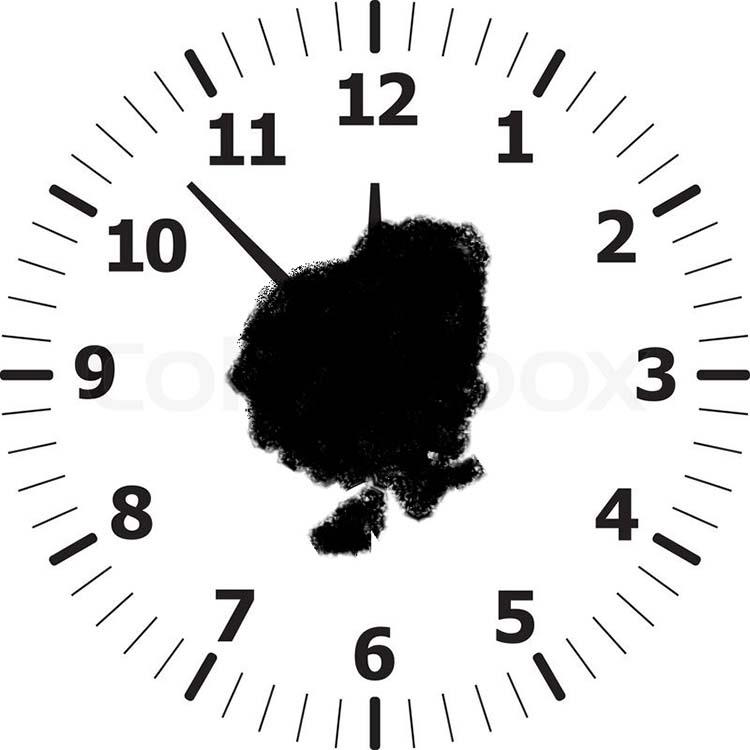Eccentric viewing is a strategy that helps people with central vision loss, mostly due to age-related macular degeneration, to read more easily and fluently. It involves the patient learning to look around a central scotoma in order to see detail. It relies on the patient locating a still healthy area of retina around the atrophic macula, and learning to fixate and then read with this new preferred retinal locus.
First, I describe a case of low vision where modified eccentric viewing was introduced as a means of helping visual rehabilitation and then a second case where optical low vision aids were helpful.
Case 1
Patient SM, a 63 year old female, had complained of reduced vision in each eye for the last 20 years. Her distance acuity was down to count fingers at under one metre in the right eye and count fingers at two metres in left eye. At presentation, she was using +10.00 DS glasses with base in prism in a small, LVA frame¹ (figure 1), and her aided near vision was <N48 in the right eye and N24 in left eye (at 10 cm).
Other clinical findings were as follows:
IOP:
- R 18 mm Hg, L 14 mm Hg
Fundus exam
- R early nucleosclerotic cataract
- L central areolar choroidal dystrophy and geographic atrophy at the macula
The visual prognosis was that improvement was unlikely.
In a bid to help the patient to better use their residual vision for reading and TV viewing, and to improve orientation and mobility around the house (however minimal this improvement maybe), we tried the following low vision aids
- Distance binocular telescopic glasses² (figure 2)
- Uniocular telescopic glasses³ in for near viewing with the left eye (figure 3)
- TV Spects4 (figure 4)
This offered little improved visual performance.

Figure 2: Distance binocular telescopic glasses
We then attempted to encourage eccentric viewing with the somewhat better left eye. A six prism diopter base up prism was introduced to attempt to shift the retinal image away from the area of atrophy. Although there was no difference in measured acuity, the patient reported some improvement in general orientation within their surroundings.
And with +10.00 DS with six prism diopters of base up prism, the patient could not only read the N18 print, but also reported that there was now no missing of individual letters, as is usually the case with the vision of those suffering from macular degeneration (figure 5).

Figure 3: Uniocular telescopic glasses for left eye near viewing
While looking at the centre of a clock with hands, the AMD patient may see the clock’s numbers but not the hands. Unlike this schematic, the figures will appear blurred as peripheral retina is much less able to resolve detail than the photoreceptor rich macular area.

Figure 4: TV Specs
The following near vision glasses from Essilor were dispensed:
RE Plano stock single vision (1.50 index with Titus coating
LE +10.00 DS with six prism base up (Omega 1.50 index with Titus coating)
This case highlights the use of prism to shift the image in a vertical direction in order to encourage eccentric viewing and offer some improvement in vision and hopefully to help to rehabilitate a low vision patient.
Case 2
When spectacles and contact lenses both fail to effect any improvement in vision, for example in cases suffering from pathology, low vision aids often come to the rescue by providing some improvement that might aid the patient’s awareness of their surroundings (and therefore mobility), and perhaps improve their chances of reading the newspaper again – even if just the headlines.
RPS was an 82 year old male and resident of a village in Bihar. He had visited his relative in Delhi who subsequently brought him to see us at our eye clinic.5 His complaint was of defective vision for the last two years. The patient already used a cane and, despite significantly reduced vision in both eyes, managed to move about independently. But his condition was miserable in that he could neither watch TV (he only listened to what the newsreader said) nor even read the headlines of a newspaper.

He suffered from low grade nucleosclerotic cataract in both eyes, had a corneal opacity in left eye, and also had scarring of the macula in both eyes. His vision in either eye was to count fingers from a distance of half a meter. There was no history of diabetes, but he was hypertensive for which he had medication. Refraction in either eye was inconclusive, and there was no improvement in vision with glasses or pinhole. His retinal specialist had advised a low vision assessment.
Finding the optimum low vision aid is time consuming, but the outcome (as in this case) is always rewarding. We prescribed the following:
- a uniocular telescopic LVA (similar to that shown in figure 3) improved the patient’s distance acuity in the left eye to 6/24-
- Spectacle magnifiers of +11.00DS allowed him to read N18 (from around 15cm)
The difference was that he now could make out faces on TV and again manage to read newspaper headlines.
Dr Narendra Kumar is an optometrist and author and works in New Delhi, India at the Opthacare Eye Centre
References
1 High plus power prismatic glasses in a small LVA frame are made by Baliwalla & Homi Private Limited, Mumbai.
2 Distance binocular telescopic glasses are made by Vision 2020 Low Vision Resource Centre, Hong Kong.
3 Uniocular as well as binocular telescopic glasses are made by Everest Telescopic Lens, Kolkata.
4 TV Spects are made by Tech Optics International, USA.
5 Ophthacare Eye Centre, Janakpuri, New Delhi.
